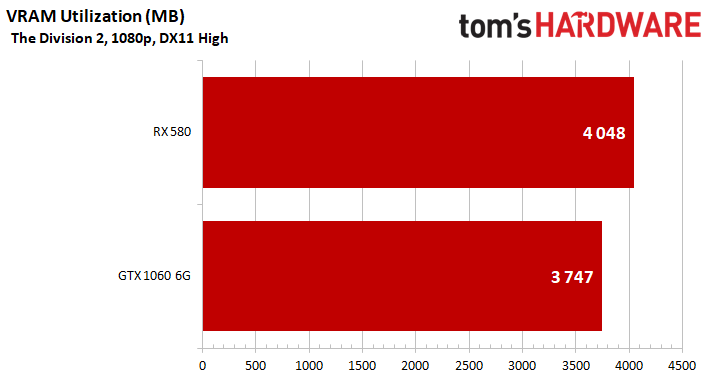Tom Clancy's The Division 2: Performance On AMD and Nvidia GPUs
CPU, RAM, and Graphics Memory Performance
Now we're going to look at how The Division 2 manages the CPU resources at its disposal. Ubisoft's minimum requirements specify a quad-core processor, so our Ryzen should theoretically run well. We tested the chip with simultaneous multi-threading enabled under DirectX 11 and DirectX 12 using a 1920 x 1080 resolution. We also limited the game's frame rate to 60 FPS for an ideal comparison between AMD's Radeon RX 580 and Nvidia's GeForce GTX 1060 6GB.
DirectX 12





The Snowdrop Engine appears to be well-optimized for threading; no logical core seems significantly more utilized than the others. It also looks like the engine has a preference for physical cores.
Overall, host processor utilization looks a little higher on the GeForce GTX 1060 6GB than AMD's card.
System and graphics memory occupancy is higher with the Radeon RX 580 under DirectX 12.
DirectX 11





The workload gets tougher under DirectX 11 as CPU utilization increases on both graphics cards. Our Ryzen processor is uniformly more taxed with a GeForce GTX 1060 6GB installed. Strangely, we notice an imbalance in the way logical cores are leveraged with a Radeon RX 580 in our test system. Two or three threads seem more loaded than the others.
When we switch to DirectX 11, the game becomes more memory-intensive with a GeForce installed than a Radeon, while graphics memory occupancy is still higher on the Radeon.
MORE: Best Graphics Cards
Get Tom's Hardware's best news and in-depth reviews, straight to your inbox.
MORE: Desktop GPU Performance Hierarchy Table
MORE: All Graphics Content
Current page: CPU, RAM, and Graphics Memory Performance
Prev Page Performance Ranked by Graphics Quality/API Next Page Multi-Core Performance



